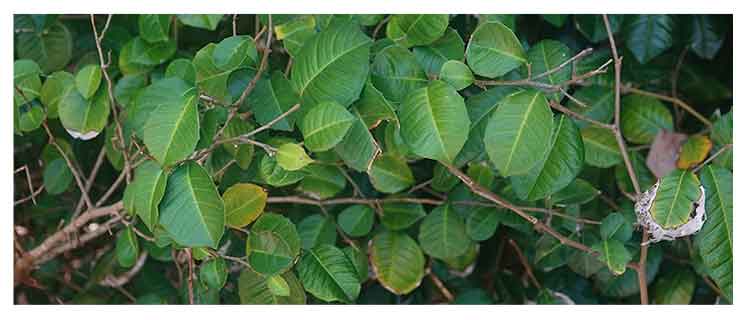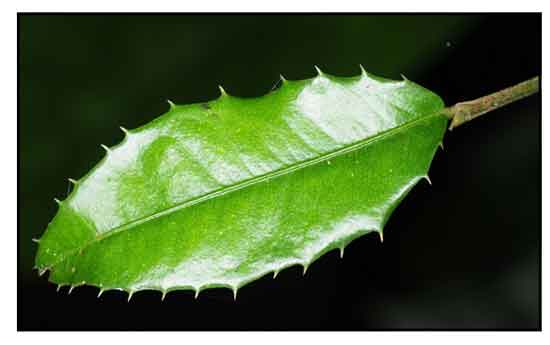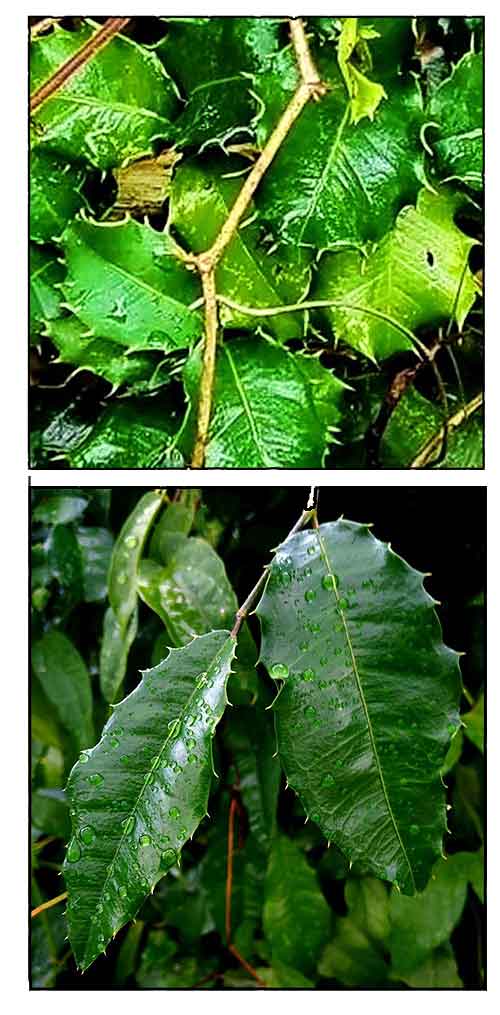 Gen info Gen info
•
Taxotrophis ilicifolia is a species of flowering plant in the family Moraceae. Six species are accepted.
• Etymology: The genus name Taxotrophis is derived from the Greek words taxos, meaning arrangement or order, and trophis, meaning nourishment or feeding, likely referring to the plants habit or leaf arrangement. The specific epithet ilicifolia derives from Latin ilex, the Latin name for Holm oak, and folium, meaning leaf, referring to the leaf shape resembling that of an ilex or holly. (AI) The genus name Streblus derives from the Greek word streblos, meaning "crooked or distorted", referring to the twigs. The specific name ilicifolius derives from Latin, meaning "fern-like leaves".
Botany
• Shrub or tree to 10(–20) m tall, much-branched, often with terminal or lateral thorns to 4.5 cm long, dioecious. Leafy twigs 1–3 mm thick, brownish to whitish puberulous, usually on one side only or more densely, (or glabrous). Leaves distichous; lamina oblong, elliptic, suborbicular, ovate or obovate, 4–12(–25) by 2–5(–10.5) cm, coriaceous, apex acuminate to acute, acumen spinulose, usually with 3 teeth, base rounded to cuneate, margin spinulose-dentate or entire; both surfaces glabrous; midrib prominent above, lateral veins 8–12 pairs, tertiary venation largely parallel to the lateral veins; petiole 0.2–1 cm long, puberulous adaxially (or hairy all round or glabrous); stipules 0.3–0.8 cm long, free or basally connate, (sub)glabrous, caducous; terminal bud aculeate in dry material. Staminate inflorescences axillary, solitary (or in pairs), spicate; peduncle ca 0.1 cm long, sparsely minutely puberulous; spike 1–5 cm long; flowers numerous, perianth 1–1.2 mm long, minutely puberulous, stamens 2–2.5 mm long, anthers 0.6–0.8 mm long; bracts basally attached, 0.3–1.3 mm long, sparsely minutely puberulous. Pistillate inflorescences axillary, solitary, (sub)racemose or uniflorous; peduncle 0.3–1.5 cm long, minutely puberulous; flowers 1–3; pedicel 2–8 mm long, minutely puberulous; tepals 1–2 mm long, ciliolate, the outer ones to 3 mm long in fruit, the inner ones to 10 mm long; ovary 1–1.5 mm long, style 0.5–1 mm long, stigmas 2–3.5 mm long; bracts basally attached, 0.3–0.5 mm long, ciliolate. Drupe 1–1.3 cm long, dehiscent, whitish; endocarp body subglobose to ellipsoid, 0.6–0.8 cm long. (eFlora of Thailand)
 • Growth form: It is a shrub or tree, up to 10 m tall, often with spines (up to 4.5 cm long). Bark is grayish black and lenticellate. Foliage: Leaves are leathery, elliptic to obovate shaped (4 - 25 cm long and 2 -10 cm wide) and often with toothed margin, sometimes entire. Leaves are distichously arranged and smooth on both surfaces. Apex is acuminate to acute, and base is rounded to cuneate. There are 8–12 pairs of lateral veins and tertiary venation are largely parallel to the lateral veins. Stipule is 0.3 – 0.8 cm long which fall off early, leaving a ring-like scar. Flowers: Occurring at the axillary, male inflorescences (1 – 5 cm long) consist of many flowers. Female inflorescences (1 – 4 cm long) is also axillary, consisting of 3–6 flowers with bracts basally attached. Style is 0.5 mm -1 mm long and stigma is 2 – 3.5 mm long. Fruit: Fruit is subglobose to ellipsoid about 1 – 1.3 cm long. (Flora & Fauna Web) • Growth form: It is a shrub or tree, up to 10 m tall, often with spines (up to 4.5 cm long). Bark is grayish black and lenticellate. Foliage: Leaves are leathery, elliptic to obovate shaped (4 - 25 cm long and 2 -10 cm wide) and often with toothed margin, sometimes entire. Leaves are distichously arranged and smooth on both surfaces. Apex is acuminate to acute, and base is rounded to cuneate. There are 8–12 pairs of lateral veins and tertiary venation are largely parallel to the lateral veins. Stipule is 0.3 – 0.8 cm long which fall off early, leaving a ring-like scar. Flowers: Occurring at the axillary, male inflorescences (1 – 5 cm long) consist of many flowers. Female inflorescences (1 – 4 cm long) is also axillary, consisting of 3–6 flowers with bracts basally attached. Style is 0.5 mm -1 mm long and stigma is 2 – 3.5 mm long. Fruit: Fruit is subglobose to ellipsoid about 1 – 1.3 cm long. (Flora & Fauna Web)
Distribution
- Native to the Philippines. (1) (2)
- In dry thickets and thin forests at low elevation. Also on limestone. (2)
- Also native to Assam, Bangladesh, Borneo, Cambodia, China South-Central, China Southeast, Hainan, Laos, Lesser Sunda Is., Malaya, Maluku, Myanmar, New Guinea, Sulawesi, Sumatera, Thailand, Vietnam. (1)
 Constituents Constituents
- Study of EtOAc extract of wood of stems isolated two new secondary metabolites, taxotrophises A and B (1,2), together with five known compounds (3-7). (see study below) (4)
- Study of
n-BuOH fraction of bark isolated and purified 16 compounds, identified as: icariside E5 (1), secoisolariciresinol 9-O-β-glucopyranoside (2), 2,4,6-trimethoxyphenol-1-O-β-D-glycoside(3),9-O-β-glucopyranosyl trans-cinnamyl alcohol(4), 3,4,5-trimethoxyphenyl-1-O-β-apiofuranosyl-(1″→6′)-β-glucopyranoside(5),3-hydroxy-4,5-dimethoxyphenyl-β-D-glucopyranoside(6), 2,6-dimethoxy-4- hydroxyphenol-1-O-β-D-glucopyranoside (7), isotachioside(8), ficuscarpanoside A(9), uridine(10), methyl syringate 4-O-β-D-glucopyranoside (11), 3,4,5-trimethoxyphenyl-β-D-glucopyranoside(12), luteolin(13), ginsenoside Rg1(14), (+)-lyonirenisol-3α-O-β-D-glucopyranoside (15), myricetin 3-neohesperidoside (16).
(5)
- Study of air-dried bark of S. ilicifolius isolated a new phenylpropanoid glycoside, pheglycoside A (1), along with four known aromatic glucosides (2-5) and three known lignan glycosides (6-8). (6)
- Study of Streblus ilicifolius leaves isolated 12 undescribed megastigmane glycosides, streilicifolosides A-L (1-12), together with 8 known analogues (13-21). (see study below) (7)
-
Study of EtOAc-soluble fraction of stems isolated two new stilbene derivatives, strebluses C and D.
(see study below) (8)
- Study of leaves isolated two new amide glycosides, streblusoamides A and B (1,2), along with 11 known compounds (3-13). (see study below) (9)
- Phytochemical screening of dried wood extracts yielded five compounds, namely, (E)-2,4-dihydroxy-3-(3,7-dimethyl-2,6-octadienyl) benzaldehyde (1), p-hydroxybenzoic acid methyl ester (2), umbelliferone (3), moracin M (4), trans-resveratrol (5).
(see study below) (11) Properties
- Studies have suggested α-glucosidase inhibitory, anti-inflammatory, tyrosinase inhibitory, antimicrobial properties.
Parts used
Stems, bark.
Uses
Edibility
- No information found on edibility.
Folkloric
- No reported folkloric medicinal use in the Philippines.
- In Vietnam, bark used as anti-pimple medicine. (8)
Others
- Wood: Wood is hard and heavy. Heartwood streaked or mottled with green or dark brown, sometimes almost black. Used extensively for making walking sticks. (3)
Studies
• Taxotrophises / α-Glucosidase Inhibitory Activity / Stems: Study of EtOAc extract of wood of stems isolated two new secondary metabolites, taxotrophises A and B (1,2), along with five known compounds (3-7). Compounds 1 and 4 showed strongest α-glucosidase inhibitory activity with IC50s of 6.5 and 1.5 µM, respectively, stronger than positive control, acarbose (IC50 214.5 µM). (4)
• Megastimane Glycoside / Anti-Inflammatory / Leaves: Study of Streblus ilicifolius leaves isolated 12 undescribed megastigmane glycosides, streilicifolosides A-L (1-12), together with 8 known analogues (13-21). All compounds were tested for inhibitory effect on production of NO in LPS-treated RAW264.7 cells. Streilicifoloside E and platanionoside D exhibited potent anti-inflammatory activity comparable to positive control, with IC50s of 26.33 and 21.84 µM, respectively. Two compounds markedly decreased secretion of PGE2 and TNF-α and inhibited expression of COX-2, iNOS, and NF-kB/p65 in LPS-induced RAW264.7 cells in a dose-dependent manner. Results suggest streilicifoloside E and platanionoside D are potential candidates for development of new anti-inflammatory agents. (7)
• Tyrosinase Inhibitors / Stems: Study of EtOAc-soluble fraction of stems isolated two new stilbene derivatives, strebluses C and D. Streblus C exhibited strong tyrosinase inhibitory activity with IC50 of 0.01 µM. Docking studies confirmed compound 1 showed better binding affinity for oxytyrosinase than that of 2. (8)
• Amide Glycosides / Anti-Inflammatory / Leaves: Study of leaves isolated two new amide glycosides, streblusoamides A and B (1,2), along with 11 known compounds (3-13). All isolates were tested for inhibition of NO production in lipopolysaccharide (LPS)-induced RAW264.7 cells. Results showed compounds 1, 5 and 6 moderately inhibited release of NO production with IC50s ranging from 50.90 to 64.79 µM. (9)
• Antimicrobial / Tyrosinase Inhibitory / Dried Wood: Study evaluated various extracts of macerated dried wood of Streblus ilicifolius for phytochemical content, tyrosinase inhibitory and antimicrobial activities. The ethanol extract exhibited tyrosinase inhibition and antimicrobial activity against Gram(+) bacteria, Staphylococcus epidermis and S. aureus. Phytochemical screening yielded five compounds. Compound 4, moracin M, exhibited tyrosinase inhibition with IC50 of 67.69 µg/ml, while compound 1,
(E)-2,4-dihydroxy-3-(3,7-dimethyl-2,6-octadienyl) benzaldehyde showed strong activity against S. epidermis, S. aureus, and methicillin-resistant S. aureus (MRSA) with MIC of 8, 4, and 8 µg/ml respectively and MBC of 32, 16, and 64 µg/ml, respectively. Results suggest potential for commercial applications such as facial whitening and anti-acne cream. (see constituents above) (11)
• Strebluses / Tyrosinase Inhibitory / Stems: Bioactivity-guided study of EtOAc-soluble fraction of stems of Streblus ilicifolius isolated four new stilbene-like derivatives, Strebluses E-H. Streblus E exhibited potent tyrosinase inhibitory activity with IC of 0.1 µM. With in silico modeling, the S value and ligand-protein interactions suggested Streblus E has lower binding affinity for oxy-tyrosinase than that of Streblus C. (12)
• Strebluses A and B / Tyrosinase Inhibitory / Stems: Study of EtOAc-soluble extract of stems of Streblus ilicifolius isolated two new secondary metabolites, strebluses A and B (1,2). All compounds were tested for tyrosinase inhibitory activity. They showed weaker inhibitory activity than that of kojic acid (!C50 44.6 µM). (13)
Availability
- Wild-crafted. |

![]()






